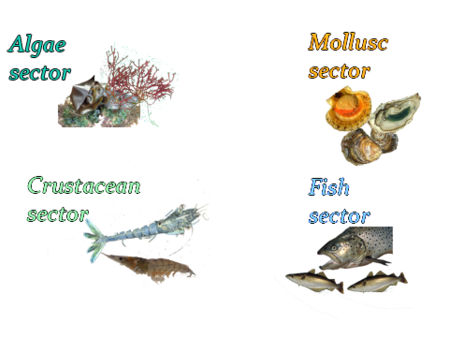Gilthead seabream
Name : | Gilthead seabream |
|---|---|
Scientific name : | Sparus aurata belongs to the sparids family, found in large numbers along our coasts (red porgy, saddled beam, boops boops, salpa salpa …). |
Size : | maximum length 70 cm, weight about 5 kg |
History : from the pioneers to present…
The gilthead seabream, like the European seabass and the turbot, has been the object of intensive farming as early as the seventies. The rearing of seabream larvae is more complex than that of the bass due to the very small size of the larvae at hatching, which implies the use of Brachionus-type rotifers as first live prey, before the artemia-type crustacean larvae (at the nauplius stage).
The main problems solved today concern :
- the development of «enrichment» feed, live preys intended for the larvae, that enable increasing the quantity of polyunsaturated fatty acids, free aminoacids, and vitamins,
- the adoption of «skimmers», which eliminate the fat film that forms at the surface of the ponds, thus enabling the larvae to come up to the surface to inflate their swim bladder and then undergo subsequently a normal growth,
- the development of micro-granulates that enable feeding the larvae as early as possible.
There is a «fresh water» larva rearing method and a «green water» method; the latter includes the addition of unicellular algae during the feeding period on rotifers. For reasons of regularity and quality of production, the «green water» method – albeit more complex – is the most widely used today in commercial hatcheries.
Rearing techniques and production cycle
The gilthead seabream is a «protandrous successive hermaphrodite» species, which means in simpler terms, that a seabream individual can be first male and then female. Natural egg laying is easily achieved in captivity. A female can lay 1 million eggs per kg each year, in several successive layings. The eggs – the diameter of which is about 0.9 mm – give birth to minute larvae (less than 3 mm), the weight of which does not exceed a few tens of milligrams.
A seabream, like a bass, can lay eggs all year round, thanks to a modification of the rearing temperature and of the «duration of the day».
The feeding pattern of the seabream larvae is more frequently used for marine fish. Following a feeding period using rotifers (0.15 to 0.25 mm), which is the most critical period of the rearing, larvae are fed small crustacean larvae ( Artemia at the nauplius stage, between 0.4 and 0.5 mm), they are «weaned», that is to say fed micro-granulates once their weight reaches about 20 to 50 mg, roughly after slightly more than one month of rearing at 20°C.
It takes between a year and a half and two years, depending on the climatic conditions, to produce "portion" size fish (300-500 g).
Seabream yields evolution
The farmed production of seabream increased at a rate of 30 % per year between 1992 and 2002, as it did for the bass.
Seabream is the largest marine farmed fish in the Mediterranean, and its production exceeded that of open sea fishing in 1993. France is the fourth largest producer of seabream juveniles which are, for the most part, exported to the major producing countries (Greece, Turkey, Italy, Spain).
Source FAO 2008 data 2006
Product value enhancement
Seabream is commercialized as whole fish, usually at the ‘’portion’’ size (300g-500g), although producer – especially in France - can provide larger fish (800g-1000g) which sell at a higher price per kilo.
Sea bream figures
100 000 | Mediterranean production in tons |
|---|---|
1,100 | French production in tons |
20 | number of seabream growout farms along the French coastline. |
Strengths / Weaknesses
Strengths | Weaknesses |
|---|---|
|
|

